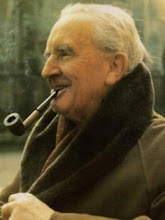
I have ''writer's block'' again (I think...and on Pentecost of all days!). I really ought to continue with my ''synopsis'' of The Silmarillion, only I can't honestly be bothered with it; its very hot and writing something of that sort can be quite laborious. I have found that the best ''synopsis'' of the whole Middle-earth stuff is provided by Tolkien himself in a letter he wrote to Milton Waldman in 1951, shortly before the publication of The Lord of the Rings. The letter is about 15 pages long, if you can take the time to read it; its quite in-depth but doesn't go into as much detail as I have (for example, Tolkien used a few short paragraphs to propound the creation and early history of Arda; I, on the other hand, have used several posts of about 1000 words each!)
Detail and succinctness present problems in a subject such as Tolkien. The immense work is so detailed, so meticulous that you really can't say anything without saying too much (and therefore also too little!) without taking something fundamental away from the whole. Certainly, one problem that I have (and this is reflected in some of my academic work too; for which I am often marked down) is that I ''don't see the wood for the trees'' (I think that is how that saying goes). Some details that I pick up on, not just in Tolkien but in any piece of literature, seem fundamentally important and I get distracted by elaborating upon them - I could explain the implications of one word in relation to another, or some concept, using several paragraphs. Consequently, I loose sight of the ''big picture.'' People sometimes forget that details make up a big picture (trees make up a woodland don't they?)
I do enjoy writing posts about the Legendarium, and if readers find them interesting too, then I shall continue with them. I started this blog in order to help and encourage people in the reading of Tolkien's work and to present it in its Catholic understanding, which is the only real understanding of Tolkien. I have great enthusiasm for it (I am not a ''fan'' though; since I hate that word). I am not socially-aware, at the best of times. This presents another problem too. Writing on Tolkien is easy for me, if done in the comfort of my own home with no distractions. But since trying to articulate this enthusiasm in a social context proves extremely difficult (you must remember that I have to juggle Tolkien with other pressing thoughts such as when to say ''please,'' ''thank you,'' ''excuse me,'' when or if to interrupt or disagree with someone - it becomes impossible when more than one person is speaking to me at the same time, thats when I switch off) blogging seemed the only logical alternative.
This is becoming an alarming blog post! It isn't meant to be! Anyway, I think I have gone on long enough. Tomorrow, I shall post something either on the origin of the Orcs or the passing of the Elves into the West (it may be easier to talk about Orcs though, considering where I shall spend tomorrow afternoon!) Happy Feast Day all readers!



























